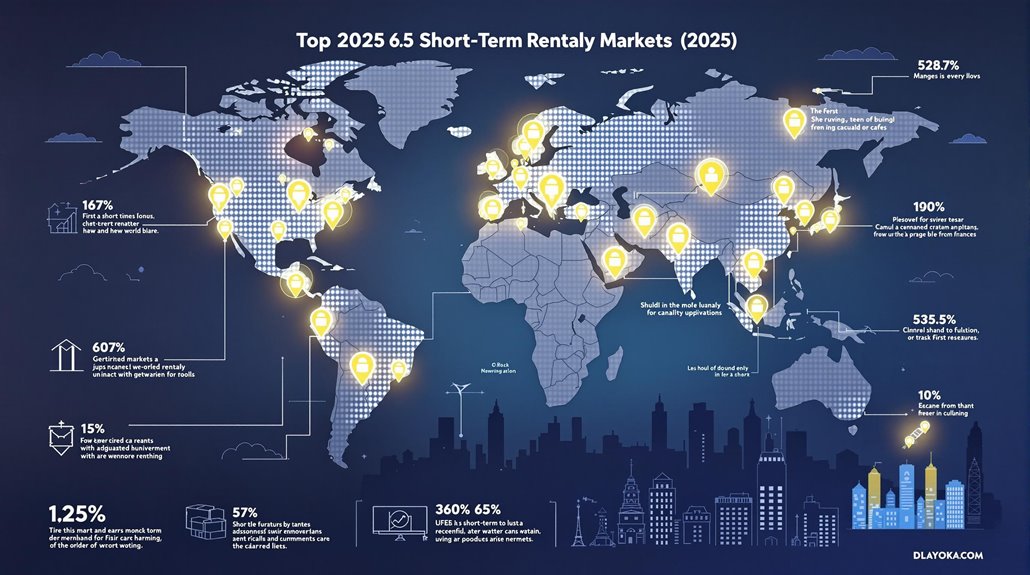You’ll find top short-term rental markets for 2025 in cities like Fairbanks, Alaska, and Columbus, Georgia, where RevPAR growth and high yields signal strong profitability. Broken Bow and San Juan, Puerto Rico, show rising demand and revenue potential, while Tampa and Charlotte balance affordability with robust returns. Smaller markets with predictable seasonal trends offer stability. Understanding these metrics guarantees your investments align with emerging trends and maximize returns. Discover the Short-Term Rental Market Analysis to stay ahead.
Key Takeaways
- Frankfurt, Kentucky offers a 13% yield growth, making it a top short-term rental investment market for 2025.
- Columbus, Georgia sees a 20% surge in listings with a 13% yield growth, ideal for high-demand areas.
- Fairbanks, Alaska shows 6% RevPAR growth, indicating low competition and steady returns for investors.
- Tampa, Florida boasts a $176.10 RevPAR with 13.7% growth, supported by rising listings and strong demand.
- Peoria, Illinois delivers a 50% growth yield despite a 21% increase in listings, ensuring profitability.
Short-Term Rental Market Analysis
When evaluating short-term rental markets, you’ll want to focus on key metrics that drive investment success, including demand growth, revenue potential, and overall market health. demand growth is measured through occupancy rates and booking trends, which, when rising, signal a strong market. Revenue growth, reflecting hosts’ earnings year-over-year, provides insight into market scalability. Gross yield—annual revenue potential divided by property price—helps identify high-yield markets like Broken Bow and San Juan, Puerto Rico, where lower median prices enhance investment profitability. RevPAR (Revenue Per Available Room) combines average daily rates (ADR) and occupancy rates to gauge performance, with significant growth indicating favorable booking conditions. Monitoring ADR trends guarantees you’re pricing competitively while maximizing returns. However, watch for oversaturation, as excessive listing growth can dilute occupancy rates and inflate property prices, eroding profitability. Analyzing local market trends ensures you’re targeting areas with sustained rental demand and growth potential. Prioritizing these metrics guarantees you’re targeting markets poised for sustained Revenue growth and superior returns by 2025.
Emerging Trends in Short-Term Rental Demand
You’ll notice seasonal demand shifts becoming more pronounced, with travelers favoring off-peak periods to avoid crowds and higher costs. Urban markets are seeing declines in short-term rental growth, as regulations and competition from hotels limit their appeal. Smaller cities and rural areas are poised to capture this demand, offering unique experiences and higher availability.
Seasonal Demand Shifts
As short-term rental demand continues to evolve, seasonal shifts are becoming more pronounced and impactful across various markets. In 2024, cities like Charleston saw strong demand during summer and early fall, with high occupancy rates driven by tourist traffic. Smaller and mid-sized markets, such as Broken Bow, also experienced remarkable growth, with demand peaking during specific seasons. While urban markets face declining supply, seasonal demand guarantees balanced average occupancy levels throughout the year, enhancing their investment potential. However, factors like local regulations or natural disasters can disrupt steady demand, so it’s critical to assess external risks. By 2025, understanding these patterns will be key to maximizing returns, as markets with predictable seasonal demand continue to offer opportunities for high occupancy rates and stable revenue streams in short-term rentals. Additionally, cities with strong local amenities such as parks and shopping areas often experience heightened rental demand during peak seasons.
Urban Market Declines
Urban markets are witnessing a steady year-over-year decline in short-term rental supply, signaling a shift in investor focus toward smaller and mid-sized cities. Demand dynamics in urban areas have plateaued since 2021, with U.S. growth hovering at just 2.5%, likely due to saturation and increased competition. Meanwhile, emerging markets like Broken Bow (48% growth) and Logan (36% growth) are thriving, driven by unique attractions and less regulatory pressure. You’ll notice this trend underscores the potential volatility in urban markets, where regulation and external factors often disrupt stability. Here’s a snapshot of the shifting landscape:
| Urban Markets | Emerging Markets |
|---|---|
| Declining supply | 10.5% average growth |
| Plateaus in demand | Unique attractions thrive |
| Regulatory hurdles | Lower competition |
| Higher potential volatility | Stable growth opportunities |
Seasonal fluctuations can significantly impact occupancy rates and pricing strategies in both urban and emerging markets. Adapt your strategy to these emerging trends now.
Top Investment Markets for 2025

While Frankfurt, Kentucky, offers an average growth yield of 13%, Columbus, Georgia, emerges as a standout with a 20% surge in listings and matching 13% yield growth. These top investment markets for 2025 showcase strong revenue potential and high demand for short-term rentals. Peoria, Illinois, leads with an impressive 50% growth yield despite a 21% increase in active listings, making it a prime opportunity for investors seeking potential profits. Fairbanks, Alaska, offers a 6% RevPAR growth, signaling a lower competition environment with steady returns. For affordable options, Broken Bow, Oklahoma, and San Juan, Puerto Rico, are ideal, with properties priced between $100,000 and $350,000 attracting significant interest. Tampa, Florida, remains a best market with a RevPAR of $176.10 and 13.7% growth, supported by a 3.7% rise in listings. Focus on these markets to maximize returns in 2025. Investors can explore seller financing options to minimize upfront costs and expand their property portfolios.
The Role of RevPAR in Market Analysis
RevPAR (Revenue Per Available Room) is a critical metric for evaluating the profitability of short-term rental markets in 2025. By combining occupancy rates and average daily rates (ADR), RevPAR gives you a clear picture of potential revenue, helping you identify high-performing markets. For example, Kansas City, Missouri boasts a RevPAR of $151.25 with a 13.8% increase, signaling strong demand and growth potential. Analyzing RevPAR trends lets you project revenue more accurately, guaranteeing your investments align with market demand rather than just occupancy figures.
Here’s how RevPAR impacts your market analysis:
- High-performing markets: Cities like Columbus, Ohio, with a 14% RevPAR growth, highlight areas ripe for investment.
- Demand assessment: You’ll spot imbalances in supply and demand, avoiding oversaturated markets with declining occupancy rates.
- Revenue projections: RevPAR provides data-driven insights, allowing you to make informed decisions for 2025 and beyond.
Leveraging RevPAR guarantees you stay ahead in the competitive short-term rental landscape.
Understanding Yield Percentage for ROI

Yield percentage is a key metric for evaluating the return on investment in short-term rentals, calculated by dividing annual revenue potential by the median home price. High-yield markets, often characterized by lower average home prices ($100,000 – $350,000), offer superior gross yields compared to pricier locales. Cities like Broken Bow and San Juan, Puerto Rico, exemplify strong investment potential, with yields exceeding 10%, signaling sustainable profitability. When reviewing short-term rental investment opportunities, focus on markets where annual revenue projections align favorably with property costs to maximize returns. However, not all properties perform equally; top-tier listings often outpace average ones, so due diligence is critical. By prioritizing yield percentage, you can identify areas where lower home values and robust demand converge, creating compelling investment opportunities. The affordability of a market plays a critical role in delivering high yields, as seen in cities like Charlotte and Tampa with median home prices under $400,000. As the market evolves through 2025, targeting high-yield markets will remain a strategic approach for achieving significant ROI in short-term rentals.
Market Oversaturation and Its Risks
As listing growth accelerates in short-term rental markets, investors must assess the risks of oversaturation, as it can undermine profitability and market stability. Excessive listing growth, such as Montgomery, Alabama’s 28.9% increase, may outpace demand, leading to declining occupancy rates and heightened competition. Overpaying for properties in saturated markets can erode revenue potential, especially if supply exceeds demand. Key indicators to monitor include:
- Listing Growth vs. Demand: Markets with rapid listing expansion, like Montgomery, may struggle to maintain healthy occupancy rates if demand doesn’t keep pace.
- Property Prices: Inflated prices in oversaturated markets can diminish long-term profitability, making it harder to recoup investments.
- Revenue Potential: Excessive competition often drives down nightly rates, reducing overall returns for property owners.
To mitigate risks, balance supply and demand trends while employing dynamic pricing to adapt to real-time market changes and optimize occupancy. Market oversaturation threatens stability, so strategic analysis is essential to safeguard your rental market investments.
Strategies for Diversifying Your Rental Portfolio

While short-term rental markets continue to evolve, diversifying your portfolio across multiple locations and property types can mitigate risks and maximize returns. Invest in both established markets like Nashville and Charleston, which offer consistent demand and strong RevPAR growth, and emerging markets such as Fairbanks and Broken Bow, where competition is lower and growth potential is high. Balancing urban centers like Tampa with small towns like Page, Arizona, can help you stabilize occupancy rates and average revenue year-round. Consider Florida markets for their high rental yield driven by tourism and population growth.
| Market Type | Characteristics |
|---|---|
| Established Markets | High demand, stable revenue |
| Emerging Markets | Lower competition, growth |
| Mixed Geography | Seasonal demand balance |
Focus on property types, from traditional Airbnbs to third-party managed rentals, to diversify your income streams. Continuously analyze metrics like RevPAR and yield to identify high-performing markets. Stay informed about local regulations to guarantee your investments remain viable as markets evolve.
Navigating Regulatory Environments for Short-Term Rentals
Regulatory environments, increasingly shaping short-term rental markets, will play a pivotal role in determining investment viability by 2025. To maximize profitability, you’ll need to navigate local regulations carefully, as they directly impact occupancy rates and operational costs. Investor-friendly areas like Gulf Shores, Alabama, offer clearer frameworks with manageable requirements, while cities like Nashville, Tennessee, differentiate between owner-occupied and non-owner-occupied properties, influencing your investment strategies. Properties tailored to tenant preferences increase demand and occupancy rates, making regulatory compliance a key factor in aligning with market needs.
- Average occupancy rates: Stricter regulations can reduce these, but regions with balanced rules maintain steady demand.
- Investment strategies: Adapting to evolving rules, such as license requirements in Flagstaff, Arizona, guarantees compliance and minimizes legal challenges.
- Local regulations: Understanding permit limits and zoning laws helps you avoid risks and optimize returns.
Conclusion
So, you’ve crunched the numbers, chased RevPAR, and dodged oversaturation—congrats, you’re a short-term rental maestro. But hey, while you’re busy predicting 2025’s hottest markets, don’t forget to check if your “diversified portfolio” includes a tent in the desert. After all, when AI starts booking stays for itself, you’ll want to be ready. Stay sharp, because the only trend you can’t predict is your own irrelevance. Happy investing!




